Impact of Extreme Wind and Freshwater Runoff on the Salinity Patterns of a Mesotidal Coastal Lagoon
Abstract
:1. Introduction
2. Study Area
3. Methods
3.1. Model Implementation
- 1987/88 by the Hydrographic Institute of the Portuguese Navy (HIPN), for the overall lagoon;
- 2011 by PLRA, for the lagoon’s main channels;
- 2011 by the Directorate-General for Territory (DGT), for the intertidal areas;
- 2020 by the University of Aveiro (UA), for the inlet channel [47];
- 2020 by the Aveiro Port Administration (APA), at a restricted area of the Mira Channel;
- 2022 by EMODnet Bathymetry Digital Terrain Model (DTM), for the continental shelf [48].
3.2. Model Evaluation Methods
3.3. Model Establishment and Scenario Definition
4. Results
4.1. Model Validation
4.2. Vertical Structure of the Ria de Aveiro Main Channels
5. Discussion
5.1. Model Performance Assessment
5.2. Vertical Salinity Structure of the Ria de Aveiro Main Channels
6. Conclusions
- The Espinheiro channel behaves as a partially mixed estuary, with salinity stratification found on the interface between the ocean water and freshwater masses, and increasing with the freshwater runoff. The local wind action mixture the water column and destroys salinity stratification, being the channel well-mixed for extreme wind scenarios, although it is not able to completely mix the water column under extreme freshwater runoff scenarios. NW storms push the estuarine front downstream, while SW storms are more effective than NW storms in destroying salinity stratification;
- Ílhavo channel behaves as a well-mixed estuary regardless of the freshwater runoff and wind conditions. The salinity intrusion is pushed downstream as the freshwater runoff increases, being the channel completely filled with freshwater under extreme scenarios;
- Mira channel generally behaves as a well-mixed estuary, but can present salinity stratification in the connection between the channel and the inlet for extreme freshwater scenarios. Windstorm scenarios are able to destroy the aforementioned stratification, and SW windstorms push the salinity intrusion downstream;
- São Jacinto channel presented perhaps the most interesting features, revealing an unusual estuarine pattern, with low salinity water masses midway of the channel and higher salinity water masses trapped upstream. It was found that this pattern is due to the advection of a freshwater plume generated by the Vouga and Antuã rivers. SW storms favour upstream currents that push the freshwater plume inward, while NW storms retain the plume outside the São Jacinto channel.
Author Contributions
Funding
Institutional Review Board Statement
Informed Consent Statement
Data Availability Statement
Conflicts of Interest
References
- Kjerfve, B.; Magill, K.E. Geographic and Hydrodynamic Characteristics of Shallow Coastal Lagoons. Mar. Geol. 1989, 88, 187–199. [Google Scholar] [CrossRef]
- Kjerfve, B. Chapter 1 Coastal Lagoons. In Elsevier Oceanography Series; Kjerfve, B., Ed.; Coastal Lagoon Processes; Elsevier: Amsterdam, The Netherlands, 1994; Volume 60, pp. 1–8. [Google Scholar]
- Smith, N.P. Chapter 4 Water, Salt and Heat Balance of Coastal Lagoons. In Elsevier Oceanography Series; Kjerfve, B., Ed.; Coastal Lagoon Processes; Elsevier: Amsterdam, The Netherlands, 1994; Volume 60, pp. 69–101. [Google Scholar]
- Ji, X.; Sheng, J.; Tang, L.; Liu, D.; Yang, X. Process Study of Circulation in the Pearl River Estuary and Adjacent Coastal Waters in the Wet Season Using a Triply Nested Circulation Model. Ocean Model. 2011, 38, 138–160. [Google Scholar] [CrossRef]
- Xu, J.; Long, W.; Wiggert, J.D.; Lanerolle, L.W.J.; Brown, C.W.; Murtugudde, R.; Hood, R.R. Climate Forcing and Salinity Variability in Chesapeake Bay, USA. Estuaries Coasts 2012, 35, 237–261. [Google Scholar] [CrossRef]
- Okpeitcha, O.V.; Chaigneau, A.; Morel, Y.; Stieglitz, T.; Pomalegni, Y.; Sohou, Z.; Mama, D. Seasonal and Interannual Variability of Salinity in a Large West-African Lagoon (Nokoué Lagoon, Benin). Estuar. Coast. Shelf Sci. 2022, 264, 107689. [Google Scholar] [CrossRef]
- Moller, O.O.; Castaing, P.; Salomon, J.-C.; Lazure, P. The Influence of Local and Non-Local Forcing Effects on the Subtidal Circulation of Patos Lagoon. Estuaries 2001, 24, 297–311. [Google Scholar] [CrossRef]
- Castelao, R.M.; Moller, O.O., Jr. A Modeling Study of Patos Lagoon (Brazil): Flow Response to Idealized Wind and River Discharge: Dynamical Analysis. Braz. J. Oceanogr. 2006, 54, 1–17. [Google Scholar] [CrossRef]
- Andrade, M.M.; Abreu, P.C.; Ávila, R.A.; Möller, O.O. Importance of Winds, Freshwater Discharge and Retention Time in the Space–Time Variability of Phytoplankton Biomass in a Shallow Microtidal Estuary. Reg. Stud. Mar. Sci. 2022, 50, 102161. [Google Scholar] [CrossRef]
- Marin Jarrin, M.J.; Sutherland, D.A. Wind Effects on the Circulation of a Geometrically Complex Small Estuary. Estuar. Coast. Shelf Sci. 2022, 278, 108092. [Google Scholar] [CrossRef]
- Zemlys, P.; Ferrarin, C.; Umgiesser, G.; Gulbinskas, S.; Bellafiore, D. Investigation of Saline Water Intrusions into the Curonian Lagoon (Lithuania) and Two-Layer Flow in the Klaipeda Strait Using Finite Element Hydrodynamic Model. Ocean Sci. 2013, 9, 573–584. [Google Scholar] [CrossRef] [Green Version]
- Scully, M.E.; Friedrichs, C.; Brubaker, J. Control of Estuarine Stratification and Mixing by Wind-Induced Straining of the Estuarine Density Field. Estuaries 2005, 28, 321–326. [Google Scholar] [CrossRef]
- Silva, F.; Duck, R. Historical Changes of Bottom Topography and Tidal Amplitude in the Ria de Aveiro, Portugal—Trends for Future Evolution. Clim. Res 2001, 18, 17–24. [Google Scholar] [CrossRef] [Green Version]
- De Jonge, V.N.; Schuttelaars, H.M.; van Beusekom, J.E.E.; Talke, S.A.; de Swart, H.E. The Influence of Channel Deepening on Estuarine Turbidity Levels and Dynamics, as Exemplified by the Ems Estuary. Estuar. Coast. Shelf Sci. 2014, 139, 46–59. [Google Scholar] [CrossRef]
- Ralston, D.K.; Talke, S.; Geyer, W.R.; Al-Zubaidi, H.A.M.; Sommerfield, C.K. Bigger Tides, Less Flooding: Effects of Dredging on Barotropic Dynamics in a Highly Modified Estuary. J. Geophys. Res. Oceans 2019, 124, 196–211. [Google Scholar] [CrossRef] [Green Version]
- Dias, J.M.; Pereira, F.; Picado, A.; Lopes, C.L.; Pinheiro, J.P.; Lopes, S.M.; Pinho, P.G. A Comprehensive Estuarine Hydrodynamics-Salinity Study: Impact of Morphologic Changes on Ria de Aveiro (Atlantic Coast of Portugal). J. Mar. Sci. Eng. 2021, 9, 234. [Google Scholar] [CrossRef]
- Salles, P.; Valle-Levinson, A.; Sottolichio, A.; Senechal, N. Wind-Driven Modifications to the Residual Circulation in an Ebb-Tidal Delta: Arcachon Lagoon, Southwestern France. J. Geophys. Res. Oceans 2015, 120, 728–740. [Google Scholar] [CrossRef]
- Vaz, N.; Dias, J. Residual Currents and Transport Pathways in the Tagus Estuary, Portugal: The Role of Freshwater Discharge and Wind. J. Coast. Res. 2014, 70, 610–615. [Google Scholar] [CrossRef]
- Malta, E.; Stigter, T.; Pacheco, A.; Dill, A.M.M.; Tavares, D.; Santos, R. Effects of External Nutrient Sources and Extreme Weather Events on the Nutrient Budget of a Southern European Coastal Lagoon. Estuaries Coasts 2016, 40, 419–436. [Google Scholar] [CrossRef] [Green Version]
- Ribeiro, A.F.; Sousa, M.; Picado, A.; Ribeiro, A.S.; Dias, J.M.; Vaz, N. Circulation and Transport Processes during an Extreme Freshwater Discharge Event at the Tagus Estuary. J. Mar. Sci. Eng. 2022, 10, 1410. [Google Scholar] [CrossRef]
- Alekseenko, E.; Roux, B. Numerical Simulation of the Wind Influence on Bottom Shear Stress and Salinity Fields in Areas of Zostera Noltei Replanting in a Mediterranean Coastal Lagoon. Prog. Oceanogr. 2018, 163, 147–160. [Google Scholar] [CrossRef] [Green Version]
- Fernandes, E.H.L.; Dyer, K.R.; Moller, O.O.; Niencheski, L.F.H. The Patos Lagoon Hydrodynamics during an El Niño Event (1998). Cont. Shelf Res. 2002, 22, 1699–1713. [Google Scholar] [CrossRef]
- Dias, J.M. Contribution to the Study of the Ria de Aveiro Hydrodynamics. Ph.D. Thesis, Universidade de Aveiro, Aveiro, Portugal, 2001. [Google Scholar]
- Vaz, N. Study of Heat and Salt Transport Processes in the Espinheiro Channel (Ria de Aveiro). Ph.D. Thesis, Universidade de Aveiro, Aveiro, Portugal, 2007. [Google Scholar]
- Vargas, C.I.C.; Vaz, N.; Dias, J.M. An Evaluation of Climate Change Effects in Estuarine Salinity Patterns: Application to Ria de Aveiro Shallow Water System. Estuar. Coast. Shelf Sci. 2017, 189, 33–45. [Google Scholar] [CrossRef]
- Lopes, J.F.; Dias, J.M. Residual Circulation and Sediment Distribution in the Ria de Aveiro Lagoon, Portugal. J. Mar. Syst. 2007, 68, 507–528. [Google Scholar] [CrossRef]
- Ulbrich, U.; Christoph, M.; Pinto, J.G.; Corte-Real, J. Dependence of Winter Precipitation over Portugal on NAO and Baroclinic Wave Activity. Int. J. Climatol. 1999, 19, 379–390. [Google Scholar] [CrossRef]
- Raible, C.C. On the Relation between Extremes of Midlatitude Cyclones and the Atmospheric Circulation Using ERA40. Geophys. Res. Lett. 2007, 34, L07703. [Google Scholar] [CrossRef]
- Betts, N.L.; Orford, J.D.; White, D.; Graham, C.J. Storminess and Surges in the Southwestern Approaches of the Eastern North Atlantic: The Synoptic Climatology of Recent Extreme Coastal Storms. Mar. Geol. 2004, 210, 227–246. [Google Scholar] [CrossRef]
- Liberato, M.L.R.; Pinto, J.G.; Trigo, R.M.; Ludwig, P.; Ordóñez, P.; Yuen, D.; Trigo, I.F. Explosive Development of Winter Storm Xynthia over the Subtropical North Atlantic Ocean. Nat. Hazards 2013, 13, 2239–2251. [Google Scholar] [CrossRef] [Green Version]
- Liberato, M.L.R. The 19 January 2013 Windstorm over the North Atlantic: Large-Scale Dynamics and Impacts on Iberia. Weather Clim. Extrem. 2014, 5, 16–28. [Google Scholar] [CrossRef] [Green Version]
- Ferreira, J.A.; Pradhan, P.K.; Liberato, M.L.R. Impacts of extratropical cyclone Stephanie assessed by a high resolution model setting. In Proceedings of the International Conference Mathematics and Engineering in Marine and Earth Problems (MEME’2014), Aveiro, Portugal, 22–25 July 2014; Aveiro University: Aveiro, Portugal, 2014; pp. 92–97. [Google Scholar]
- Pinheiro, J.P.; Lopes, C.L.; Ribeiro, A.S.; Sousa, M.C.; Dias, J.M. Tide-Surge Interaction in Ria de Aveiro Lagoon and Its Influence in Local Inundation Patterns. Cont. Shelf Res. 2020, 200, 104132. [Google Scholar] [CrossRef]
- Silveira, F.; Lopes, C.L.; Pinheiro, J.P.; Pereira, H.; Dias, J.M. Coastal Floods Induced by Mean Sea Level Rise—Ecological and Socioeconomic Impacts on a Mesotidal Lagoon. J. Mar. Sci. Eng. 2021, 9, 1430. [Google Scholar] [CrossRef]
- Lopes, C.; Azevedo, A.; Dias, J. Flooding Assessment under Sea Level Rise Scenarios: Ria de Aveiro Case Study. J. Coast. Res. 2013, 65, 766–771. [Google Scholar] [CrossRef]
- Dias, J.M.; Lopes, J.; Dekeyser, I. Hydrological Characterisation of Ria de Aveiro, Portugal, in Early Summer. Oceanol. Acta 1999, 22, 473–485. [Google Scholar] [CrossRef] [Green Version]
- Lopes, C.L. Flood Risk Assessment in Ria de Aveiro Under Present and Future Scenarios. Ph.D. Thesis, Universidade de Aveiro, Aveiro, Portugal, 2016. [Google Scholar]
- Lopes, C.; Plecha, S.; Silva, P.; Dias, J. Influence of Morphological Changes in a Lagoon Flooding Extension: Case Study of Ria de Aveiro (Portugal). J. Coast. Res. 2013, 165, 1158–1163. [Google Scholar] [CrossRef]
- Araújo, I.B.; Dias, J.; Pugh, D.T. Model Simulations of Tidal Changes in a Coastal Lagoon, the Ria de Aveiro (Portugal). Cont. Shelf Res. 2008, 28, 1010–1025. [Google Scholar] [CrossRef]
- Silva, J.F. Circulação Da Água Na Ria de Aveiro: Contribuição Para o Estudo Da Qualidade Da Água. Ph.D. Thesis, Universidade de Aveiro, Aveiro, Portugal, 1994. [Google Scholar]
- Moreira, M.H.; Queiroga, H.; Machado, M.M.; Cunha, M.R. Environmental Gradients in a Southern Europe Estuarine System: Ria de Aveiro, Portugal Implications for Soft Bottom Macrofauna Colonization. Netherland J. Aquat. Ecol. 1993, 27, 465–482. [Google Scholar] [CrossRef]
- Dias, J.M.; Lopes, J.F.; Dekeyser, I. Tidal Propagation in Ria de Aveiro Lagoon, Portugal. Phys. Chem. Earth Part B Hydrol. Ocean. Atmos. 2000, 25, 369–374. [Google Scholar] [CrossRef]
- Génio, L.; Sousa, A.; Vaz, N.; Dias, J.M.; Barroso, C. Effect of Low Salinity on the Survival of Recently Hatched Veliger of Nassarius Reticulatus (L.) in Estuarine Habitats: A Case Study of Ria de Aveiro. J. Sea Res. 2008, 59, 133–143. [Google Scholar] [CrossRef]
- Vicente, C.M. Caracterização Hidráulica e Aluvionar da Ria de Aveiro—Utilização de Modelos Hidráulicos no Estudo de Problemas. Jorn. Ria Aveiro 1985, 3, 41–58. [Google Scholar]
- Dias, J.M.; Fonseca, A.; Picado, A.; Lopes, C.L.; Silva, J.; Vaz, L.; Mendes, R.; Plecha, S. Estudos da Evolução e da Dinâmica Costeira e Estuarina da Ria de Aveiro no âmbito do Polis Litoral da Ria de Aveiro; 3rd Technical Report; Universidade de Aveiro: Aveiro, Portugal, 2011; 42p. [Google Scholar]
- Deltares. Delft3D-FLOW User Manual; Deltares: Delft, The Netherlands, 2022. [Google Scholar]
- Cavalinhos, R.; Correia, R.; Rosa, P.; Lillebo, A.I.; Pinheiro, L.M. Processed Multibeam Bathymetry Data Collected around the Ria de Aveiro, Portugal, Onboard the NEREIDE Research Vessel [Data Set]; Zenodo: Aveiro, Portugal, 2020. [Google Scholar]
- EMODnet Bathymetry Consortium. EMODnet Digital Bathymetry (DTM 2020). Available online: https://sextant.ifremer.fr/record/bb6a87dd-e579-4036-abe1-e649cea9881a/ (accessed on 2 January 2023).
- Matsumoto, K.; Takanezawa, T.; Ooe, M. Ocean Tide Models Developed by Assimilating TOPEX/POSEIDON Altimeter Data into Hydrodynamical Model: A Global Model and a Regional Model around Japan. J. Oceanogr. 2000, 56, 567–581. [Google Scholar] [CrossRef]
- Copernicus Marine Service. Atlantic-Iberian Biscay Irish- Ocean Physics Reanalysis. Available online: https://data.marine.copernicus.eu/product/IBI_MULTIYEAR_BGC_005_003/description (accessed on 11 January 2023). [CrossRef]
- Hersbach, H.; Bell, B.; Berrisford, P.; Hirahara, S.; Horányi, A.; Muñoz-Sabater, J.; Nicolas, J.; Peubey, C.; Radu, R.; Schepers, D.; et al. The ERA5 Global Reanalysis. Q. J. R. Meteorol. Soc. 2020, 146, 1999–2049. [Google Scholar] [CrossRef]
- Krysanova, V.; Meiner, A.; Roosaare, J.; Vasilyev, A. Simulation Modelling of the Coastal Waters Pollution from Agricultural Watershed. Ecol. Model. 1989, 49, 7–29. [Google Scholar] [CrossRef]
- Stefanova, A.; Krysanova, V.; Hesse, C.; Lillebø, A.I. Climate Change Impact Assessment on Water Inflow to a Coastal Lagoon: The Ria de Aveiro Watershed, Portugal. Hydrol. Sci. J. 2015, 60, 929–948. [Google Scholar] [CrossRef]
- Dias, J.; Picado, A. Impact of Morphologic Anthropogenic and Natural Changes in Estuarine Tidal Dynamics. J. Coast. Res. 2011, 64, 1490–1494. [Google Scholar]
- Stow, C.A.; Jolliff, J.; McGillicuddy, D.J.; Doney, S.C.; Allen, J.I.; Friedrichs, M.A.M.; Rose, K.A.; Wallhead, P. Skill Assessment for Coupled Biological/Physical Models of Marine Systems. J. Mar. Syst. 2009, 76, 4–15. [Google Scholar] [CrossRef] [Green Version]
- Warner, J.C.; Geyer, W.R.; Lerczak, J.A. Numerical Modeling of an Estuary: A Comprehensive Skill Assessment. J. Geophys. Res. Ocean. 2005, 110, C05001. [Google Scholar] [CrossRef]
- Arnold, J.G.; Allen, P.M.; Bernhardt, G. A Comprehensive Surface-Groundwater Flow Model. J. Hydrol. 1993, 142, 47–69. [Google Scholar] [CrossRef]
- Vaz, N.; Dias, J.; Martins, I. Dynamics of a Temperate Fluvial Estuary in Early Winter. Glob. Int. J. 2005, 7, 18. [Google Scholar]
- Vaz, N.; Dias, J.M. Hydrographic Characterization of an Estuarine Tidal Channel. J. Mar. Syst. 2008, 70, 168–181. [Google Scholar] [CrossRef]
- Ferreira, J.A.; Liberato, M.L.R.; Ramos, A.M. On the Relationship between Atmospheric Water Vapour Transport and Extra-Tropical Cyclones Development. Phys. Chem. Earth. 2016, 94, 56–65. [Google Scholar] [CrossRef]
- Jassby, A.D.; Kimmerer, W.J.; Monismith, S.G.; Armor, C.; Cloern, J.E.; Powell, T.M.; Schubel, J.R.; Vendlinski, T.J. Isohaline Position as a Habitat Indicator for Estuarine Populations. Ecol. Appl. 1995, 5, 272–289. [Google Scholar] [CrossRef] [Green Version]
- Díez-Minguito, M.; Contreras, E.; Polo, M.J.; Losada, M.A. Spatio-Temporal Distribution, along-Channel Transport, and Post-Riverflood Recovery of Salinity in the Guadalquivir Estuary (SW Spain). J. Geophys. Res. Ocean. 2013, 118, 2267–2278. [Google Scholar] [CrossRef]
- Andrews, S.W.; Gross, E.S.; Hutton, P.H. Modeling Salt Intrusion in the San Francisco Estuary Prior to Anthropogenic Influence. Cont. Shelf Res. 2017, 146, 58–81. [Google Scholar] [CrossRef]
- Guerra-Chanis, G.E.; Reyes-Merlo, M.; Díez-Minguito, M.; Valle-Levinson, A. Saltwater Intrusion in a Subtropical Estuary. Estuar. Coast. Shelf Sci. 2019, 217, 28–36. [Google Scholar] [CrossRef]
- Dias, J.M.; Sousa, M.C.; Bertin, X.; Fortunato, A.B.; Oliveira, A. Numerical Modeling of the Impact of the Ancão Inlet Relocation (Ria Formosa, Portugal). Environ. Model. Softw. 2009, 24, 711–725. [Google Scholar] [CrossRef]
- Mendes, R.; Vaz, N.; Dias, J. Numerical Modeling Changes Induced by the Low Lying Areas Adjacent to Ria de Aveiro. J. Coast. Res. 2011, 64, 1125–1129. [Google Scholar]
- Vaz, N.; Dias, J.M.; Leitão, P.; Martins, I. Horizontal Patterns of Water Temperature and Salinity in an Estuarine Tidal Channel: Ria de Aveiro. Ocean Dyn. 2005, 55, 416–429. [Google Scholar] [CrossRef] [Green Version]
- Vaz, N.; Miguel Dias, J.; Chambel Leitão, P. Three-Dimensional Modelling of a Tidal Channel: The Espinheiro Channel (Portugal). Cont. Shelf Res. 2009, 29, 29–41. [Google Scholar] [CrossRef]



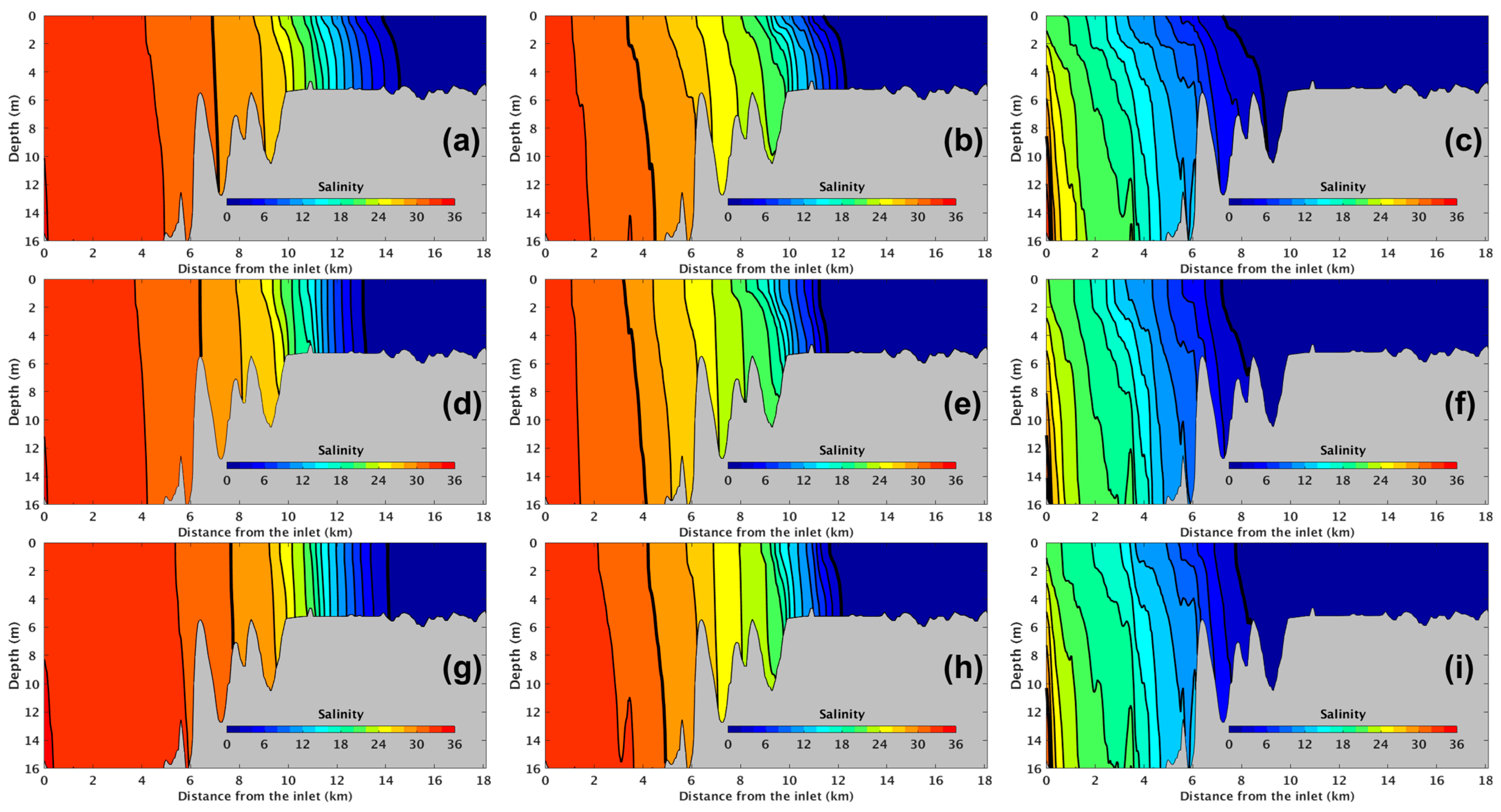

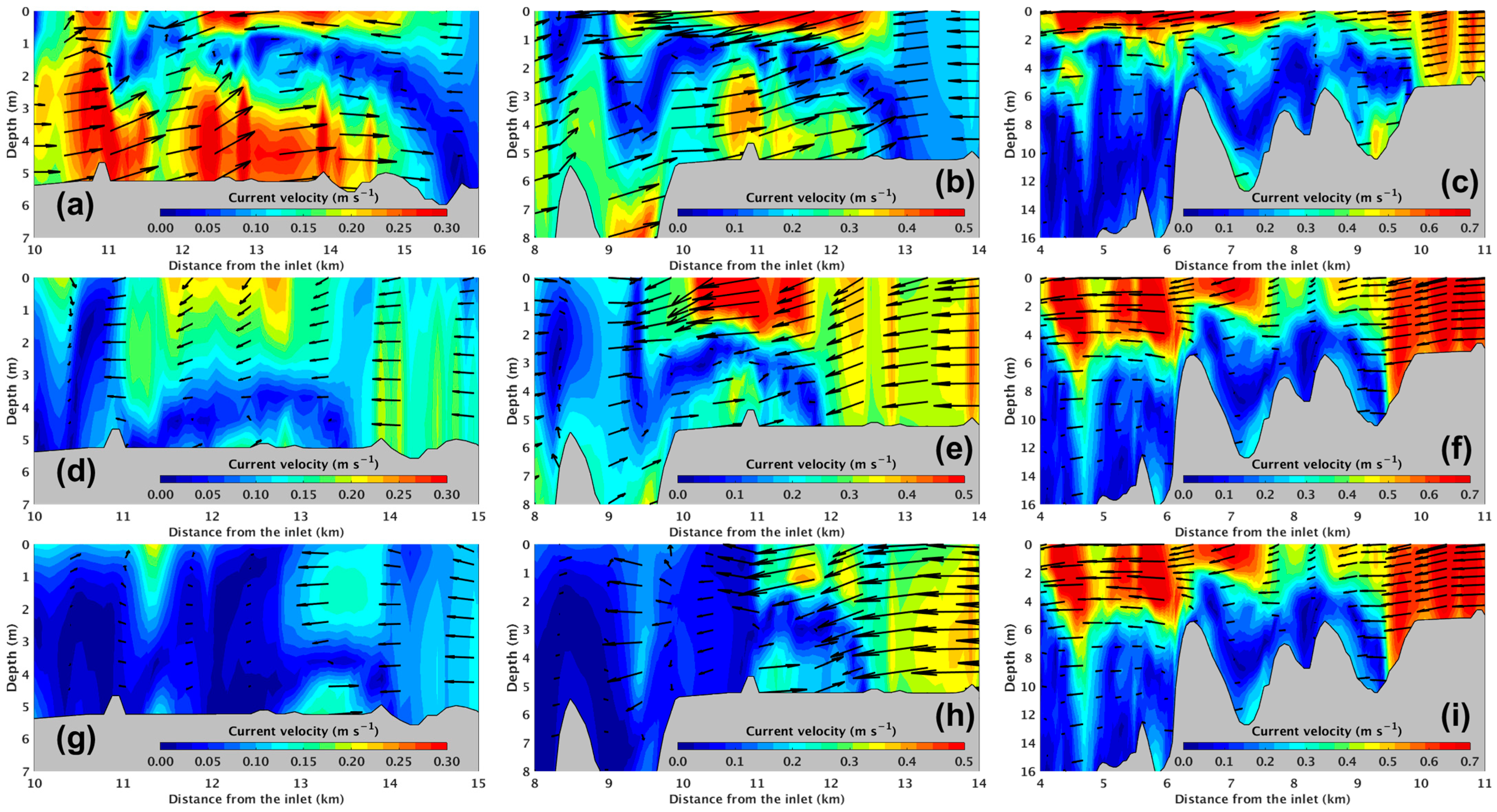
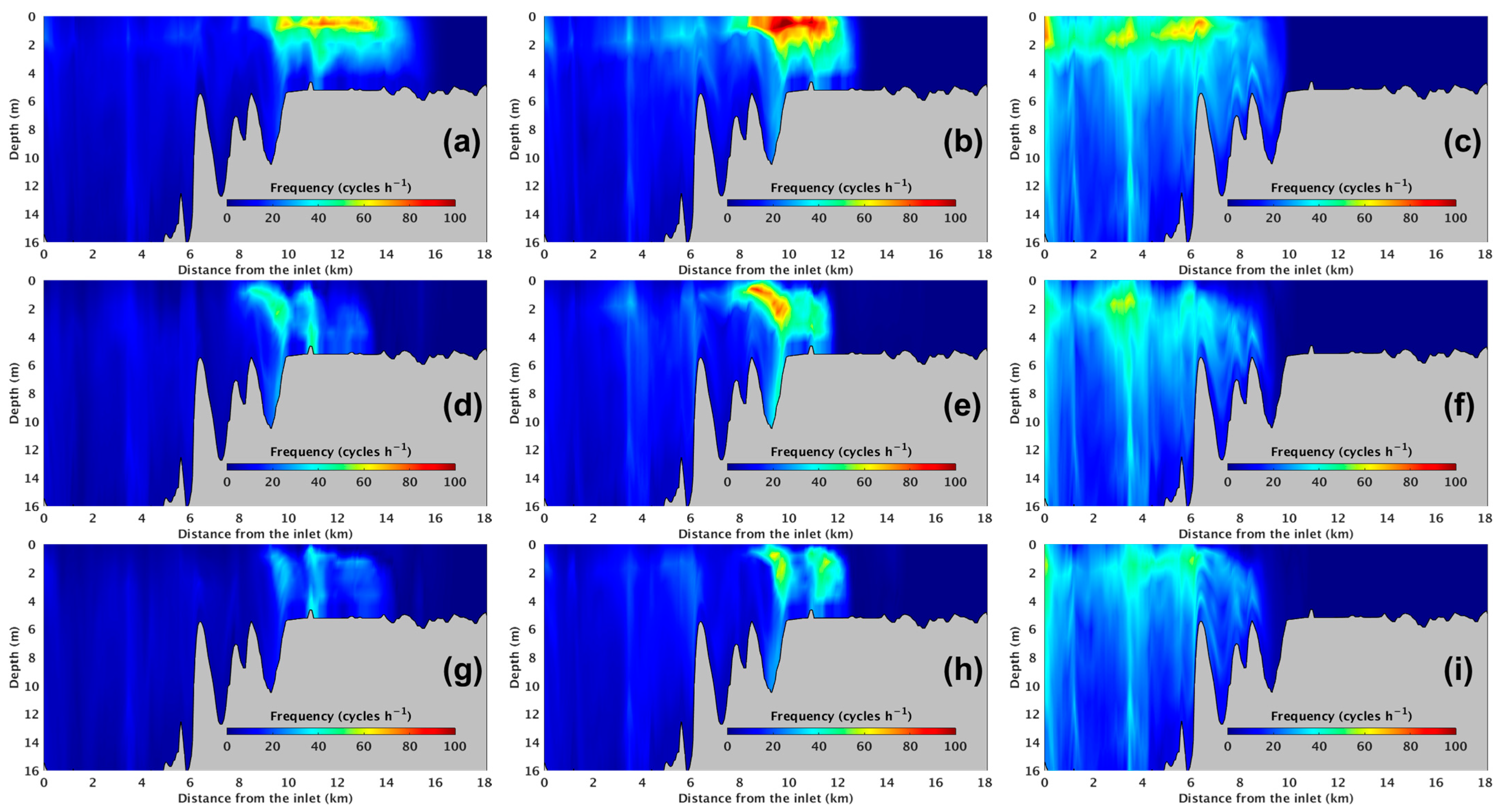









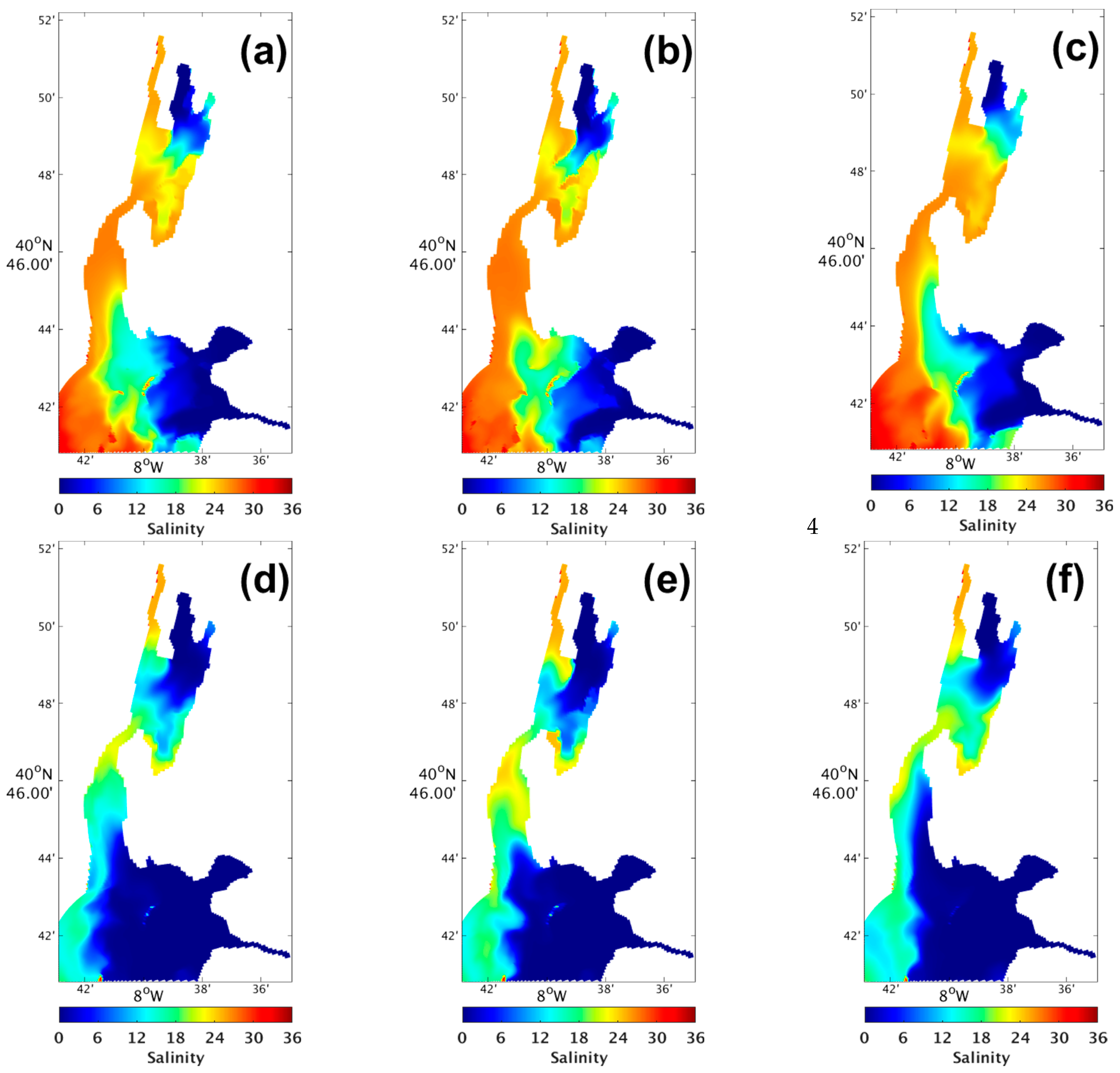
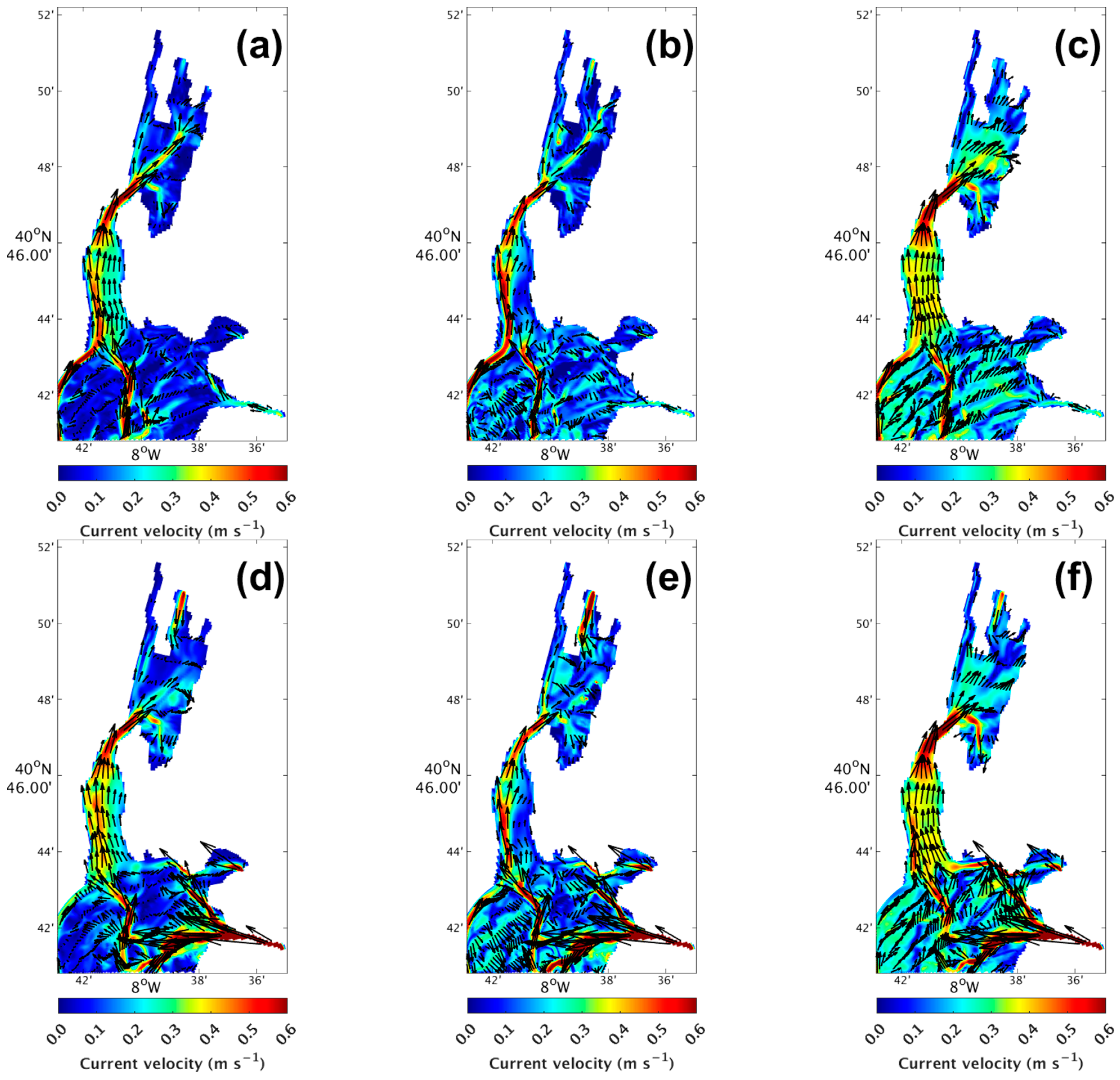
| Tributary | Return Period Flow (m3 s−1) | ||||
|---|---|---|---|---|---|
| 2 Years | 10 Years | 25 Years | 50 Years | 100 Years | |
| Vouga | 374.0 | 745.3 | 1050.2 | 1845.1 | 2241.4 |
| Cáster | 69.2 | 108.7 | 136.9 | 199.9 | 227.6 |
| Antuã | 88.8 | 144.9 | 185.1 | 276.0 | 318.0 |
| Boco | 11.5 | 25.1 | 36.3 | 63.9 | 76.9 |
| Ribeira dos Moínhos | 25.7 | 55.5 | 79.7 | 139.2 | 167.3 |
| Tributary | SWIM Mean Flow (m3 s−1) |
|---|---|
| Vouga | 88.35 |
| Antuã | 7.01 |
| Cáster | 1.92 |
| Boco | 1.66 |
| Ribeira dos Moínhos | 5.61 |
| Scenario Resume | Wind | Freshwater Runoff |
|---|---|---|
| Control | No | Climatological flow |
| Moderate flow | No | 2-year return period |
| Extreme flow | No | 100-year return period |
| Control + Windstorm NW | 60 km h−1 NW | Climatological flow |
| Moderate flow + Windstorm NW | 60 km h−1 NW | 2-year return period |
| Extreme flow + Windstorm NW | 60 km h−1 NW | 100-year return period |
| Control + Windstorm SW | 60 km h−1 SW | Climatological flow |
| Moderate flow + Windstorm SW | 60 km h−1 SW | 2-year return period |
| Extreme flow + Windstorm SW | 60 km h−1 SW | 100-year return period |
| Station | 2002/2003 | 2013/2014/2019 | ||||
|---|---|---|---|---|---|---|
| RMSE (m) | Skill | NRMSE (%) | RMSE (m) | Skill | NRMSE (%) | |
| Areão | - | - | - | 0.12 | 0.983 | 10 |
| Barra | 0.05 | 0.999 | 3 | 0.04 | 0.999 | 2 |
| Cacia | 0.25 | 0.964 | 16 | - | - | - |
| Cais do Bico | - | - | - | 0.09 | 0.996 | 4 |
| Cais da Pedra | 0.20 | 0.959 | 15 | 0.18 | 0.968 | 13 |
| Carregal | 0.57 | 0.679 | 48 | 0.13 | 0.990 | 7 |
| Chegado | - | - | - | 0.12 | 0.992 | 6 |
| Cires | 0.12 | 0.994 | 5 | - | - | - |
| Costa Nova | 0.19 | 0.979 | 12 | 0.08 | 0.997 | 4 |
| Laranjo | 0.10 | 0.995 | 5 | - | - | - |
| Lota | 0.08 | 0.997 | 4 | - | - | - |
| Ponte Cais | 0.08 | 0.997 | 4 | - | - | - |
| Ponte Varela | - | - | - | 0.09 | 0.995 | 5 |
| Puxadouro | - | - | - | 0.15 | 0.978 | 11 |
| Rio Novo | - | - | - | 0.13 | 0.992 | 6 |
| Torreira | 0.12 | 0.990 | 8 | 0.09 | 0.995 | 5 |
| Vagueira | 0.11 | 0.993 | 6 | 0.09 | 0.994 | 5 |
| Vista Alegre | 0.12 | 0.986 | 9 | 0.11 | 0.990 | 7 |
| Station | 2019 | ||
|---|---|---|---|
| RMSE (m s−1) | Skill | NRMSE (%) | |
| Cais da Pedra | 0.077 | 0.502 | 47 |
| Costa Nova | 0.093 | 0.960 | 13 |
| Ponte Varela | 0.125 | 0.942 | 12 |
| Rio Novo | 0.229 | 0.599 | 38 |
| Torreira | 0.146 | 0.928 | 17 |
| Vagueira | 0.115 | 0.865 | 25 |
| Vista Alegre | 0.095 | 0.861 | 27 |
| Station | 2013/2016 | ||
|---|---|---|---|
| RMSE | Skill | NRMSE (%) | |
| Barra | 0.79 | 0.809 | 64 |
| Chegado | 3.73 | 0.833 | 37 |
| Costa Nova | 1.06 | 0.678 | 46 |
| Ponte Varela | 4.31 | 0.621 | 59 |
| Rio Novo | 5.90 | 0.869 | 25 |
| Vagueira | 2.50 | 0.969 | 14 |
| Vista Alegre | 1.79 | 0.939 | 20 |
Disclaimer/Publisher’s Note: The statements, opinions and data contained in all publications are solely those of the individual author(s) and contributor(s) and not of MDPI and/or the editor(s). MDPI and/or the editor(s) disclaim responsibility for any injury to people or property resulting from any ideas, methods, instructions or products referred to in the content. |
© 2023 by the authors. Licensee MDPI, Basel, Switzerland. This article is an open access article distributed under the terms and conditions of the Creative Commons Attribution (CC BY) license (https://creativecommons.org/licenses/by/4.0/).
Share and Cite
Pereira, F.; Picado, A.; Pereira, H.; Pinheiro, J.P.; Lopes, C.L.; Dias, J.M. Impact of Extreme Wind and Freshwater Runoff on the Salinity Patterns of a Mesotidal Coastal Lagoon. J. Mar. Sci. Eng. 2023, 11, 1338. https://doi.org/10.3390/jmse11071338
Pereira F, Picado A, Pereira H, Pinheiro JP, Lopes CL, Dias JM. Impact of Extreme Wind and Freshwater Runoff on the Salinity Patterns of a Mesotidal Coastal Lagoon. Journal of Marine Science and Engineering. 2023; 11(7):1338. https://doi.org/10.3390/jmse11071338
Chicago/Turabian StylePereira, Francisco, Ana Picado, Humberto Pereira, João Pedro Pinheiro, Carina Lurdes Lopes, and João Miguel Dias. 2023. "Impact of Extreme Wind and Freshwater Runoff on the Salinity Patterns of a Mesotidal Coastal Lagoon" Journal of Marine Science and Engineering 11, no. 7: 1338. https://doi.org/10.3390/jmse11071338
APA StylePereira, F., Picado, A., Pereira, H., Pinheiro, J. P., Lopes, C. L., & Dias, J. M. (2023). Impact of Extreme Wind and Freshwater Runoff on the Salinity Patterns of a Mesotidal Coastal Lagoon. Journal of Marine Science and Engineering, 11(7), 1338. https://doi.org/10.3390/jmse11071338










